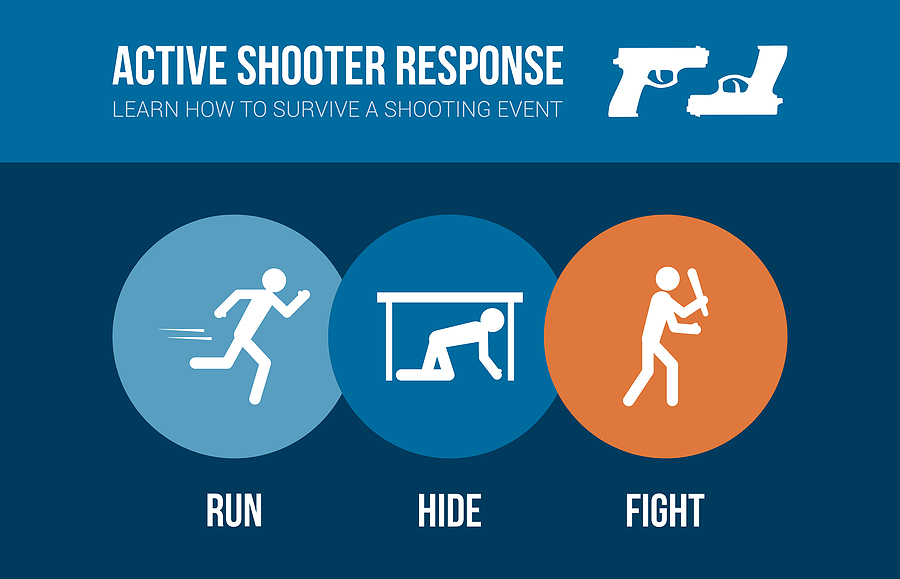Albuquerque Active Shooter Training – Steps to Take to Be Prepared for Workplace Violence

Active shooter incidents are increasing. Businesses must have systems in place to handle such circumstances. Make sure you know what to do if there is an active shooter at your work home.
Prepare for an active shooter in the workplace.
The news is constantly reporting about active shooters or mass massacres. Recent events include the VTA shooting in San Jose, a mass shooting at a Miami club, and the King Soopers shooting in Boulder, Colorado.
The numbers are shocking. In 2019, the FBI identified 28 active shooter events across 16 states. It was also discovered:
- Ninety-seven people were slain, including two cops.
- About 150 people were injured, including 15 police officers.
- Of the shooters, nine were killed by police and one by a bystander.
- Police arrested 15 alleged active shooters.
- There were 29 men and one woman among the 30 alleged shooters.
- Twelve out of 28 instances happened in commercial locations such as offices and restaurants.
What is an “Active Shooter Incident”?
According to the FBI, an “active shooter” is actively engaged in murdering or attempting to kill others inside a restricted and populous region. As a rule, active shooters like to target random people with one or more types of firearms. Before the first responders reach the scene, many accidents are over in just 10 to 15 minutes. On the other hand, some crimes go unpunished until they are put an end to by law enforcement, suicide, or the victims themselves. A large percentage of assailants are insiders who know their surroundings.
Violence in the workplace
According to the Occupational Safety and Health Administration (OSHA), it is defined as “any act or threat of violence, harassment, or intimidation that happens on the job.” In some cases, it might be as simple as verbal abuse, while it can involve violence in others. Workplace violence is more likely in professions with higher stress levels, such as delivery drivers, healthcare workers, customer service agents, and law enforcement officers.
Restaurants, supermarkets, and other necessities took a beating during the COVID-19 epidemic. Workplace violence is a greater risk for them than for the general population. Due to health and safety regulations, they have overworked personnel and dissatisfied consumers. There was a lot of slacking off in many other industries as well. COVID-19 saw a decrease in overall crime, but there was an increase in stress-related homicides.
Violent acts cannot be predicted for any single reason, but they might be more likely to occur when many elements come together. If there is violence in the workplace, there must be clear rules and procedures that say so, and those who do it will be punished very harshly.
Warning Signs for Active Shooters in the Workplace
Situations involving active shooters are inherently unpredictable, but there are warning indicators to look out for that may help reduce your danger of attack while also safeguarding the lives of individuals in your immediate vicinity. Current or former employees and associates of such individuals might all be potential active shooters at a workplace. Employers and coworkers should be taught to watch out for warning signs of violence, such as the following:
- Aggressive or unpredictable conduct with intense mood swings
- Drunkenness and drug usage
- Workplace performance changes Policy violations
- Abuse of workplace regulations or processes
- loss of concern for hygiene and appearance.
- Changes in home life or personality
- Monetary issues
- Manifesting complaints and threatening retaliation
- Uninvited remarks about guns and violent crime are on the rise.
- Empathy for violent offenders
Training for Active Shooters
Maintaining awareness of possible workplace violence signs, completing a security review of your facility, providing staff training, and drafting an Emergency Action Plan are all ways to ensure that your company is prepared for an active shooter situation (EAP). Training your employees for an active shooter event can help them be better prepared to respond, which can help them avoid a fatality or a terrible accident.
As limitations are eased, remote employees are returning to the office, and the number of customers is rising, making it even more critical to defend against the danger of workplace violence by detecting stress in the workplace. The stresses and aggravations that existed before the epidemic are still present. To meet these issues, employers must recognise and anticipate them and teach their employees what to do in the event of an escalating crisis.
An Emergency Action Plan (EAP)
Employee assistance programmes (EAPs) should include input from various departments, including human resources, training teams, facility operators, property managers, and local police enforcement and emergency responders. Department of Homeland Security wants to ensure that the EAP has the following things.
- This is the preferred method for reporting fires and other emergencies.
- There must be a plan in place for an evacuation.
- Detailed instructions on how to get out of the building in an emergency, with maps of the inside and “safe zones.”
- Local law enforcement and hospitals can be reached at the following numbers:
- Planned behaviour in the event of an emergency
Active Shooter Training Exercise
Employees can benefit significantly from active shooter training exercises by practising what to do in such a scenario. These kinds of activities can be developed with the help of local police enforcement. The training session should include the following:
- How to tell the difference between a gunshot and a scream?
- In the event of a shooting, how should one respond?
- If evacuating isn’t an option, what should you do? If you can’t, what should you do?
- Whenever it’s safe to call 911,
- During a crisis, how can you acquire a survival mindset?
- Always be aware of your surroundings and any potential threats.
- In the event of an emergency, what should I do?
Be Prepared: Prevent an Active Shooter Incident
One method to help avoid an active shooter event is to recognise behavioral warning indicators. Take these steps to prevent these kinds of accidents, the Cybersecurity and Infrastructure Security Agency says.
- Check the criminal records of all employees who regularly work in vital or sensitive areas.
- Set up a system of credentials for all workers and visitors to the office or job site that shows where they may go and what they can do.
- Visitors, contractors, cleaning teams, suppliers, and temporary employees should all be given unique badges to help them be found.
- Visitors must always show and check their ID badges to get into the building.
- Ensure that your building has a minimum of two means of escape in an emergency.
- Mark the locations of emergency exits, first-aid stations, and shelters on all of your construction site signs.
- Use what you’ve learned from previous active shooter situations when you make your emergency plan.
What Should You Do During an Active Shooter Attack?
Employees and management must be psychologically and physically prepared to cope with an active shooter scenario to protect themselves and others. During an emergency, a manager’s job is to remain calm, secure the building with locks and barricades, and transport everyone to a safe location via a predetermined escape route. Run, hide, or fight are the three most common responses to an active shooter situation.
Run
One of your first options if you find yourself in the proximity of a gunman is to flee or run. As quickly as possible, determine the safest and most convenient way out of the building. Don’t bring anything with you, and always keep your hands out in the open. Prevent other people from accessing the area where an active shooter may be lurking.
Hide
If there is no immediate escape path, hide behind any object that blocks the shooter’s direct line of sight. Using heavy furniture and locking the doors, you can prevent anyone from entering your hiding location. You should, however, keep in mind that you may need to leave your hiding place at some point. Keep your mouth shut and your phone on silent mode to don’t disturb anyone. The police will arrive soon, so stay put until then.
Fight
The last remaining choice is to engage in combat. Fighting should only be used as a last option when your life is at risk. You must be committed to your activities to incapacitate the active shooter with physical aggression in this form of response. Throw everything you can at the gunman, yell as loud as possible, and invent weapons.
Calling 911
Call 911 as soon as it is safe to do so. Keep an eye out for future assaults and help those in need if you can. Give the following information to the 911 operator or law enforcement officer:
- An active shooter’s location and those of the victims
- If there is more than one shooter, the number
- The number and type of firearms owned by the shooter/s
- Keeping the Public Arrival Safe
To stop the active shooter and eliminate any additional danger, law enforcement officers’ priority is to stop him when they arrive on the scene. A direct route to the last known site of gunfire will then be taken. Afterwards, the secondary team will point them toward a safe place where witnesses can be found and questioned, allowing the crisis to be brought under better control.
Do not make any quick movements, the point at the shooter, scream or yell, and follow the instructions of the first responders in the event of an active shooter situation. Leave the safe location only when directed by law enforcement.
Post Active Shooter Event Actions
Managers and HR should conduct post-event assessments once the active shooter has been neutralized and the situation has been stabilized.
- Make a list of everyone in the safe zone and see if anyone is missing or has been harmed. Determine the best way to tell the people who care about the victims and the people who were hurt by the incident.
- Assess the mental health of people at the scene and, if necessary, refer them to health care professionals.
- Prepare an after-action report based on your investigation of the active shooter event.
